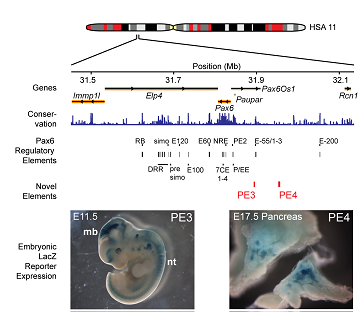New insights into regulation of gene linked to diabetes
Two new PAX6 regulatory elements identified and characterised

Diabetes is caused by the loss or dysfunction of insulin secreting cells of the pancreas. Complex genetic and environmental factors influence risk of diabetes.
Many genetic changes associated with diabetes are in DNA control sequences which can fine-tune the amount of a gene expression the process by which the information contained within a gene becomes a product within the cell .
To better understand the role of control sequence changes in disease, Professor Nick Gilbert and colleagues at the University of Edinburgh studied the gene Pax6, which is vital for correct development and function of the brain, eye and pancreas, and has been implicated in diabetes and obesity. Pax6 has one of the largest number of DNA control sequences of any gene, and is an excellent model to understand how they function.
The team identified two new Pax6 control sequences, PE3 and PE4, present and active in both human and mouse pancreatic cells and identified specific protein factors which bind to these sequences. They show that a common genetic change within the human PE4 sequence can alter its fine tuning activity. Finally the researchers used synthetically designed DNA binding factors to target these new sequences and can alter the gene expression of Pax6 and other nearby genes inside a laboratory based model pancreatic cell line.
This study further elucidates the role that the Pax6 gene has in pancreatic development, function and disease, as well as demonstrating the important role control sequences have in tuning specific gene activity across the many different cell types of the body.
Links
Original research paper: https://doi.org/10.1093/hmg/ddy255


